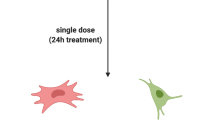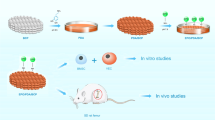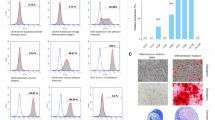Abstract
Erythropoietin (EPO) is a pleiotropic growth factor. Of interest for skeletal tissue engineering, the non-hematopoietic capabilities of EPO include its osteogenic and angiogenic potencies. The main aim of this study was to investigate the dose–response relationship and determine the lowest effective dose of EPO that reliably increases the osteogenic differentiation of human mesenchymal stromal cells (hMSCs). Additional aims were to elucidate the surface receptors and to investigate the role of the intracellular signaling pathways by blocking the mammalian target of rapamycin (mTOR), Jak-2 protein tyrosine kinase (JAK2), and phosphoinositide 3-kinases (PI3K). The primary outcome measures were two mineralization assays, Arsenazo III and alizarin red, applied after 10, 14, and 21 days. Moreover, alkaline phosphatase activity, cell number, and cell viability were determined after 2 and 7 days. A proportional dose–response relationship was observed. In vivo, the lowest effective dose of 20 IU/ml should be used for further research to accommodate safety concerns about adverse effects. Ex vivo, the most effective dose of 100 IU/ml could facilitate vascularization and bone ingrowth in cell-based scaffolds. The expression of non-hematopoietic receptors EPOR and CD131 was documented, and EPO triggered all three examined intracellular pathways. Future studies of the efficacy of EPO in cell-based tissue engineering can benefit from our findings.





Similar content being viewed by others
References
Jelkmann, W. (1992). Erythropoietin: structure, control of production, and function, 72(2). Physiological Reviews, 72(2), 449–489.
Kim, J., Jung, Y., Sun, H., Joseph, J., Mishra, A., Shiozawa, Y., et al. (2012). Erythropoietin mediated bone formation is regulated by mTOR signaling. Journal of Cellular Biochemistry, 113(1), 220–228.
Rölfing, J. H. D., Bendtsen, M., Jensen, J., Stiehler, M., Foldager, C. B., Hellfritzsch, M. B., et al. (2012). Erythropoietin augments bone formation in a rabbit posterolateral spinal fusion model. Journal of Orthopaedic Research, 30(7), 1083–1088. doi:10.1002/jor.22027.
Holstein, J. H., Menger, M. D., Scheuer, C., Meier, C., Culemann, U., Wirbel, R. J., et al. (2007). Erythropoietin (EPO): EPO-receptor signaling improves early endochondral ossification and mechanical strength in fracture healing. Life Sciences, 80(10), 893–900.
Holstein, J. H., Orth, M., Scheuer, C., Tami, A., Becker, S. C., Garcia, P., et al. (2011). Erythropoietin stimulates bone formation, cell proliferation, and angiogenesis in a femoral segmental defect model in mice. Bone, 49(5), 1037–1045.
Shiozawa, Y., Jung, Y., Ziegler, A. M., Pedersen, E. A., Wang, J., Wang, Z., et al. (2010). Erythropoietin couples hematopoiesis with bone formation. PLoS ONE, 5(5), e10853.
Ehrenreich, H., Weissenborn, K., Prange, H., Schneider, D., Weimar, C., Wartenberg, K., et al. (2009). Recombinant human erythropoietin in the treatment of acute ischemic stroke. Stroke, 40(12), e647–e656.
Brines, M., Grasso, G., Fiordaliso, F., Sfacteria, A., Ghezzi, P., Fratelli, M., et al. (2004). Erythropoietin mediates tissue protection through an erythropoietin and common beta-subunit heteroreceptor. Proceedings of the National Academy of Sciences of the United States of America, 101(41), 14907–14912.
Burger, D., Xenocostas, A., & Feng, Q. P. (2009). Molecular basis of cardioprotection by erythropoietin. Current Molecular Pharmacology, 2(1), 56–69.
Bennis, Y., Sarlon-Bartoli, G., Guillet, B., Lucas, L., Pellegrini, L., Velly, L., et al. (2012). Priming of late endothelial progenitor cells with erythropoietin before transplantation requires the CD131 receptor subunit and enhances their angiogenic potential. Journal of Thrombosis and Haemostasis : JTH, 10(9), 1914–1928.
Chateauvieux, S., Grigorakaki, C., Morceau, F., Dicato, M., & Diederich, M. (2011). Erythropoietin, erythropoiesis and beyond. Biochemical Pharmacology, 82(10), 1291–1303.
McGee, S. J., Havens, A. M., Shiozawa, Y., Jung, Y., & Taichman, R. S. (2012). Effects of erythropoietin on the bone microenvironment. Growth Factors (Chur, Switzerland), 30(1), 22–28.
Certificates of Analysis. Retrieved June 2, 2013, from http://www.lonza.com/about-lonza/knowledge-center/certificates-of-analysis.aspx.
Lysdahl, H., Baatrup, A., Nielsen, A. B., Foldager, C. B., & Bünger, C. (2013). Phenol red inhibits chondrogenic differentiation and affects osteogenic differentiation of human mesenchymal stem cells in vitro. Stem Cell Reviews and Reports, 9(2), 132–139.
Guo, L., Luo, T., Fang, Y., Yang, L., Wang, L., Liu, J., et al. (2012). Effects of erythropoietin on osteoblast proliferation and function. Clinical and Experimental Medicine. doi:10.1007/s10238-012-0220-7.
Laugsch, M., Metzen, E., Svensson, T., Depping, R., & Jelkmann, W. (2008). Lack of functional erythropoietin receptors of cancer cell lines. International Journal of Cancer, 122(5), 1005–1011.
Kato, S., Amano, H., Ito, Y., Eshima, K., Aoyama, N., Tamaki, H., et al. (2010). Effect of erythropoietin on angiogenesis with the increased adhesion of platelets to the microvessels in the hind-limb ischemia model in mice. Journal of Pharmacological Sciences, 112(2), 167–175.
Palani, S., & Sarkar, C. A. (2008). Positive receptor feedback during lineage commitment can generate ultrasensitivity to ligand and confer robustness to a bistable switch. Biophysical Journal, 95(4), 1575–1589.
Jung, Y., Song, J., Shiozawa, Y., Wang, J., Wang, Z., Williams, B., et al. (2008). Hematopoietic stem cells regulate mesenchymal stromal cell induction into osteoblasts thereby participating in the formation of the stem cell niche. Stem Cells, 26(8), 2042–2051.
Sorg, H., Krueger, C., Schulz, T., Menger, M. D., Schmitz, F., & Vollmar, B. (2009). Effects of erythropoietin in skin wound healing are dose related. The FASEB Journal, 23(9), 3049–3058.
Zwezdaryk, K. J., Coffelt, S. B., Figueroa, Y. G., Liu, J., Phinney, D. G., LaMarca, H. L., et al. (2007). Erythropoietin, a hypoxia-regulated factor, elicits a pro-angiogenic program in human mesenchymal stem cells. Experimental Hematology, 35(4), 640–652.
Eschbach, J. W., Egrie, J. C., Downing, M. R., Browne, J. K., & Adamson, J. W. (1987). Correction of the anemia of end-stage renal disease with recombinant human erythropoietin. Results of a combined phase I and II clinical trial. The New England Journal of Medicine, 316(2), 73–78.
Elliott, S., Busse, L., Bass, M. B., Lu, H., Sarosi, I., Sinclair, A. M., et al. (2006). Anti-Epo receptor antibodies do not predict Epo receptor expression. Blood, 107(5), 1892–1895.
Sinclair, A. M., Coxon, A., McCaffery, I., Kaufman, S., Paweletz, K., Liu, L., et al. (2010). Functional erythropoietin receptor is undetectable in endothelial, cardiac, neuronal, and renal cells. Blood, 115(21), 4264–4272.
Ghezzi, P., Bernaudin, M., Bernaudinb, M., Bianchi, R., Bianchic, R., Blomgren, K., et al. (2010). Erythropoietin: not just about erythropoiesis. Lancet, 375(9732), 2142.
Acknowledgments
We express our sincere gratitude to FACS Core Facility at Aarhus University, Denmark, for performing flow cytometry.
Conflicts of interest
The authors declare no potential conflicts of interest.
Financial support
We would like to extend our appreciation to the VELUX foundation for being the main financial contributor of this study. The Helga and Peter Kornings Foundation and Rygforskningsfonden i Aarhus granted additional financial support.
Author information
Authors and Affiliations
Corresponding author
Electronic supplementary material
Below is the link to the electronic supplementary material.
Figure S1
Dose-response relationship and lowest effective dose of EPO, related to Fig. 1. Absolute values comparing EPO [IU/ml] groups with osteogenic medium (Pos C) are depicted for the following outcome measures: cell viability assay (XTT), alkaline phosphatase activity (ALP), and mineralization assay Arsenazo III (Arsenazo). Cells were continuously stimulated with EPO. Proliferation medium was employed as negative control (Neg C). Data are presented as mean ± SD and post-hoc p-values against Pos C are given. (PDF 95 kb)
Figure S2
Intracellular pathway analyses, related to Fig. 5. Outcome measurements: cell viability (XTT), alkaline phosphatase activity (ALP), and primary outcome mineralization assays alizarin red (AZR) and Arsenazo III (Arsenazo) presented as absolute values. In these experiments, all hMSCs were continuously stimulated with 20 IU/ml EPO. Potential intracellular pathways were screened by constant blocking of mTOR with 10 nM rapamycin (Rapa), JAK2 with 10 μM AG490, and PI3K with 50 μM LY294002 (LY) or 50 nM wortmannin (Wort). Data are presented as mean ± SD. * p < 0.0001, ** p < 0.001. (PDF 108 kb)
Figure S3
Intracellular pathway analysis alizarin red staining after 14 days, related to Fig. 5. Representative alizarin red staining visualizing mineralization after 14 days continuous stimulation with 20 IU/ml EPO with and without inhibition with intracellular pathway inhibitors rapamycin, AG490, LY4229002 or Wortmannin. Proliferation medium was employed as negative control (Neg C). (PDF 1034 kb)
Rights and permissions
About this article
Cite this article
Rölfing, J.H.D., Baatrup, A., Stiehler, M. et al. The Osteogenic Effect of Erythropoietin on Human Mesenchymal Stromal Cells is Dose-Dependent and Involves Non-Hematopoietic Receptors and Multiple Intracellular Signaling Pathways. Stem Cell Rev and Rep 10, 69–78 (2014). https://doi.org/10.1007/s12015-013-9476-x
Published:
Issue Date:
DOI: https://doi.org/10.1007/s12015-013-9476-x




